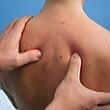Background
- The practice of applying finger pressure to specific acupoints throughout the body has been used in China since 2000 BC, prior to the use of acupuncture. Acupressure techniques are widely practiced internationally for relaxation, wellness promotion, and the treatment of various health conditions. Multiple human studies suggest the effectiveness of wrist-point (P6) acupressure for treating nausea.
- Shiatsu means finger (Shi) pressure (Atsu) in Japanese. Shiatsu technique involves finger pressure at acupoints and along body meridians. It can incorporate palm pressure, stretching, massaging, and other manual techniques. Shiatsu practitioners commonly treat musculoskeletal and psychological conditions, including neck/shoulder and lower back problems, arthritis, depression, and anxiety. Tuina (Chinese for "pushing and pulling") is similar to shiatsu but with more soft tissue manipulation and structural realignment. Tuina is a common form of Asian bodywork used in Chinese-American communities.
References
Natural Standard developed the above evidence-based information based on a thorough systematic review of the available scientific articles. For comprehensive information about alternative and complementary therapies on the professional level, go to . Selected references are listed below.
- Agarwal A, Ranjan R, Dhiraaj S, et al. Acupressure for prevention of pre-operative anxiety: a prospective, randomised, placebo controlled study. Anaesthesia 2005 Oct;60(10):978-8.
View Abstract - Barker R, Kober A, Hoerauf K, et al. Out-of-hospital auricular acupressure in elder patients with hip fracture: a randomized double-blinded trial. Acad Emerg Med 2006 Jan;13(1):19-23.
View Abstract - Chen HM,Chen CH. Effects of acupressure at the Sanyinjiao point on primary dysmenorrhoea. J Adv Nurs 2004;48(4):380-387.
View Abstract - Cho YC, Tsay SL. The effect of acupressure with massage on fatigue and depression in patients with end-stage renal disease. J Nurs.Res 2004;12(1):51-59.
View Abstract - Harris RE, Jeter J, Chan P, et al. Using acupressure to modify alertness in the classroom: a single-blinded, randomized, cross-over trial. J Altern Complement Med 2005 Aug;11(4):673-9.
View Abstract - Ho CM, Tsai HJ, Chan KH, et al. P6 acupressure does not prevent emesis during spinal anesthesia for cesarean delivery. Anesth Analg 2006 Mar;102(3):900-3.
View Abstract - Hsieh LL, Kuo CH, Lee LH, et al. Treatment of low back pain by acupressure and physical therapy: randomised controlled trial. BMJ 2006 Mar 25;332(7543):696-700.
View Abstract - Maa SH, Sun MF, Hsu KH, et al. Effect of acupuncture or acupressure on quality of life of patients with chronic obstructive asthma: a pilot study. J Altern Complement Med 2003;9(5):659-670.
View Abstract - Puangsricharern A, Mahasukhon S. Effectiveness of auricular acupressure in the treatment of nausea and vomiting in early pregnancy. J Med Assoc Thai. 2008; 91(11):1633-8.
View Abstract - Roscoe JA, Jean-Pierre P, Morrow GR, et al. Exploratory analysis of the usefulness of acupressure bands when severe chemotherapy-related nausea is expected. J Soc Integr Oncol 2006 Winter;4(1):16-20.
View Abstract - Sheehan P. Hyperemesis gravidarum--assessment and management. Aust Fam Physician 2007 Sep;36(9):698-701.
View Abstract - Smith CA, Collins CT, Cyna AM, et al. Complementary and alternative therapies for pain management in labour. Cochrane Database Syst Rev 2006 Oct 18;(4):CD003521.
View Abstract - Stein DJ, Birnbach DJ, Danzer BI, et al. Acupressure versus intravenous metoclopramide to prevent nausea and vomiting during spinal anesthesia for cesarean section. Anesth Analg 1997;84(2):342-345.
View Abstract - Tsay SL, Wang JC, Lin KC, et al. Effects of acupressure therapy for patients having prolonged mechanical ventilation support. J Adv Nurs 2005 Oct;52(2):142-50.
View Abstract - Wang SM, Escalera S, et al. Extra-1 acupressure for children undergoing anesthesia. Anesth Analg. 2008; 107(3):811-6.
View Abstract







